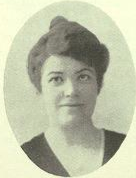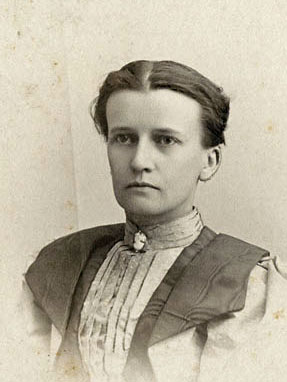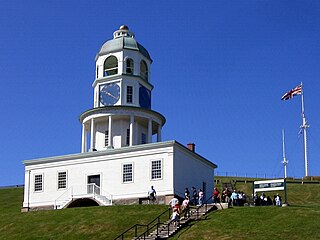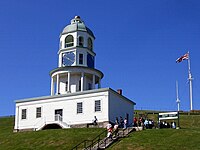
Dalhousie University is a large public research university in Nova Scotia, Canada, with three campuses in Halifax, a fourth in Bible Hill, and a second medical school campus in Saint John, New Brunswick. Dalhousie offers more than 4,000 courses, and over 200 degree programs in 13 undergraduate, graduate, and professional faculties. The university is a member of the U15, a group of research-intensive universities in Canada.

Sir Robert Laird Borden was a Canadian lawyer and politician who served as the eighth prime minister of Canada from 1911 to 1920. He is best known for his leadership of Canada during World War I.
The Woman's Christian Temperance Union (WCTU) is an international temperance organization. It was among the first organizations of women devoted to social reform with a program that "linked the religious and the secular through concerted and far-reaching reform strategies based on applied Christianity." It plays an influential role in the temperance movement. Originating among women in the United States Prohibition movement, the organization supported the 18th Amendment and was also influential in social reform issues that came to prominence in the progressive era.

NSCAD University is a public art university in Halifax, Nova Scotia, Canada. The university is a co-educational institution that offers bachelor's and master's degrees. The university also provides continuing education services through its School of Extended Studies.

Province House in Halifax is where the Nova Scotia legislative assembly, known officially as the Nova Scotia House of Assembly, has met every year since 1819, making it the longest serving legislative building in Canada. The building is Canada's oldest house of government. Standing three storeys tall, the structure is considered one of the finest examples of Palladian architecture in North America.

Pictou Academy (PA), founded in 1815 by Dr. Thomas McCulloch, is a secondary school in Pictou, Nova Scotia. Prior to the twentieth century, it was a grammar school; a liberal, nonsectarian degree-granting college; and then a secondary school. Pictou Academy's current principal is Starr Pettipas. The Pictou Academy Educational Foundation provides additional funds to the school.

Edith Jessie Archibald was a Canadian suffragist and writer who led the Maritime Women's Christian Temperance Union (WCTU), National Council of Women of Canada and the Local Council of Women of Halifax. For her many forms of social activism, she was referred to as the "Lady of Grace" by King George V, and she was designated a Person of National Historic Significance by the Government of Canada in 1997.

The history of Nova Scotia covers a period from thousands of years ago to the present day. Prior to European colonization, the lands encompassing present-day Nova Scotia were inhabited by the Mi'kmaq people. During the first 150 years of European settlement, the region was claimed by France and a colony formed, primarily made up of Catholic Acadians and Mi'kmaq. This time period involved six wars in which the Mi'kmaq along with the French and some Acadians resisted the British invasion of the region: the French and First Nation Wars, Father Rale's War and Father Le Loutre's War. During Father Le Loutre's War, the capital was moved from Annapolis Royal, Nova Scotia, to the newly established Halifax, Nova Scotia (1749). The warfare ended with the Burying the Hatchet ceremony (1761). After the colonial wars, New England Planters and Foreign Protestants immigrated to Nova Scotia. After the American Revolution, Loyalists immigrated to the colony. During the nineteenth century, Nova Scotia became self-governing in 1848 and joined the Canadian Confederation in 1867.

Edna May Williston Best (Sexton) was a social activist and war worker born in Shediac, New Brunswick and died in Halifax, Nova Scotia.
The Nova Scotia Cotton Manufacturing Company was a cotton mill located in Halifax, Nova Scotia which was founded in 1882 and destroyed with great loss of life by the Halifax Explosion in 1917.
James McGregor Stewart, was a corporate lawyer in Halifax, Nova Scotia, Canada. Using crutches as a result of polio at age two, Stewart served as head of a Halifax law firm that became the largest law firm in Atlantic Canada and today bears his name, Stewart McKelvey. He also served as the President of the Canadian Bar Association in 1941-42. In 2000, Canadian Lawyer magazine named him one of Canada's ten greatest lawyers.
Robert William Chambers was a cartoonist and illustrator from Nova Scotia whose work appeared in the Halifax Chronicle Herald. At his peak, Chambers produced nine cartoons every week: six for morning papers and three for afternoon papers. His career lasted 53 years.

The History of Canadian women is the study of the historical experiences of women living in Canada and the laws and legislation affecting Canadian women. In colonial period of Canadian history, Indigenous women's roles were often challenged by Christian missionaries, and their marriages to European fur traders often brought their communities into greater contact with the outside world. Throughout the colonial period, European women were encouraged to immigrate to Canadian colonies and expand the white population. After Confederation in 1867, women's experiences were shaped by federal laws and by legislation passed in Canada's provincial legislatures.
Dr. Thomas McCulloch was a Scottish-born, Presbyterian minister, author, educator, and education reformer. He was the founder and principal of Pictou Academy and the first principal of Dalhousie College from 1838-1843. He is the author of The Stepsure Letters (1821-1823), considered to be the first major work of humour in English Canada humour.

George Henry Wright was a significant businessman and philanthropist in Halifax, Nova Scotia. He was born at Wright's Cove, Nova Scotia and died in the sinking of the Titanic at the age of 62. He established Write's World Business Directory in Boston and later returned to Halifax and invested in the city. His own house at 989 Young Ave, and two of his public buildings, the Marble Wright Building and The Saint Paul Building, still stand in downtown Halifax. They were all built by architect James Charles Philip Dumaresq.

Dr. Eliza Ritchie was a prominent suffragist in Nova Scotia, Canada.

The Royal Acadian School was a school developed for marginalized people in Halifax, Nova Scotia. The school was established by British officer and reformer Walter Bromley on 13 January 1814. He promoted the objectives of the British and Foreign School Society in Nova Scotia, under the sponsorship of Prince Edward. The first patron was Sir John Coape Sherbrooke.

William Pearly Oliver worked at the Cornwallis Street Baptist Church for twenty-five years (1937–1962) and was instrumental in developing the four leading organizations to support Black Nova Scotians in the 20th century: Nova Scotia Association for the Advancement of Colored People (1945), the Nova Scotia Human Rights Commission (1967), the Black United Front (1969) and the Black Cultural Centre for Nova Scotia (1983). He was instrumental in supporting the case of Viola Desmond. Oliver was awarded the Order of Canada in 1984.
Maria Louisa Angwin was a Canadian physician. She was the first woman licensed to practice medicine in Nova Scotia.























